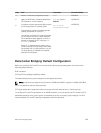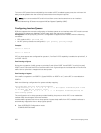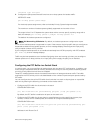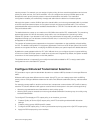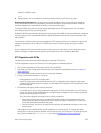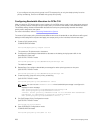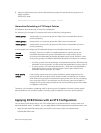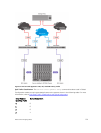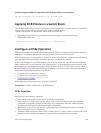
PRIORITY-GROUP mode
exit
5. Repeat Steps 1 to 4 to configure all remaining dot1p priorities in an ETS priority group.
Dell Networking OS Behavior: A priority group consists of 802.1p priority values that are grouped for
similar bandwidth allocation and scheduling, and that share latency and loss requirements. All 802.1p
priorities mapped to the same queue must be in the same priority group.
Configure all 802.1p priorities in priority groups associated with an ETS output policy. You can assign
each dot1p priority to only one priority group.
By default, all 802.1p priorities are grouped in priority group 0 and 100% of the port bandwidth is assigned
to priority group 0. The complete bandwidth is equally assigned to each priority class so that each class
has 12 to 13%.
The maximum number of priority groups supported in ETS output policies on an interface is equal to the
number of data queues (4) on the port. The 802.1p priorities in a priority group can map to multiple
queues.
If you configure more than one priority queue as strict priority or more than one priority group as strict
priority, the higher numbered priority queue is given preference when scheduling data traffic.
ETS Operation with DCBx
The following section describes DCBx negotiation with peer ETS devices.
In DCBx negotiation with peer ETS devices, ETS configuration is handled as follows:
• ETS TLVs are supported in DCBx versions CIN, CEE, and IEEE2.5.
• The DCBx port-role configurations determine the ETS operational parameters (refer to Configure a
DCBx Operation).
• ETS configurations received from TLVs from a peer are validated.
• If there is a hardware limitation or TLV error:
– DCBx operation on an ETS port goes down.
– New ETS configurations are ignored and existing ETS configurations are reset to the previously
configured ETS output policy on the port or to the default ETS settings if no ETS output policy was
previously applied.
• ETS operates with legacy DCBx versions as follows:
– In the CEE version, the priority group/traffic class group (TCG) ID 15 represents a non-ETS priority
group. Any priority group configured with a scheduler type is treated as a strict-priority group and
is given the priority-group (TCG) ID 15.
– The CIN version supports two types of strict-priority scheduling:
* Group strict priority: Use this to increase its bandwidth usage to the bandwidth total of the
priority group and allow a single priority flow in a priority group. A single flow in a group can
use all the bandwidth allocated to the group.
* Link strict priority: Use this to increase to the maximum link bandwidth and allow a flow in any
priority group.
CIN supports only the dot1p priority-queue assignment in a priority group. To configure a dot1p
priority flow in a priority group to operate with link strict priority, you configure: The dot1p priority for
strict-priority scheduling (strict-priority command; Enabling Strict-Priority Queueing).
Data Center Bridging (DCB)
267



